
Biathlon - Quick Guide
Biathlon - Overview
Biathlon is one of the most challenging winter games which gives thrilling experience in chilled winter. This winter sport is a mixture of cross-country skiing and rifle shooting. Biathlon is difficult to play because here the athletes participating in a cross country skiing race are distracted by frequent stops to shoot at sequence of targets. Biathlon is a combination of five events − individual, sprint, pursuit, relay, and mass start.
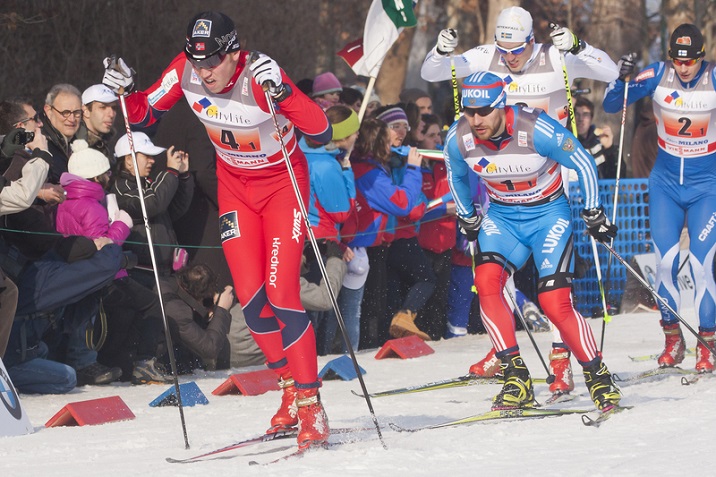
In this game, the athletes compete in cross country skiing and shoot series of targets from a distance. The athletes need to be fast, focussed, and have more stamina. Every time the target is missed the biathlete either gets an additional time or distance penalty. It is important that the skier is fast enough to maintain the competition but should be slow enough to maintain control. In this game the athletes carry a rifle and shoot the target from the distance of 50m.
A Little History of Biathlon
Biathlon has its roots in Norway where the people used it as training for the military. One of the Worlds first ever known ski club was formed in Norway in 1861. In 1924 the combination of skiing and shooting made its way to the Winter Olympics. It was then demonstrated in 1928, 1936 and 1948 but failed to regain Olympic competition back then.
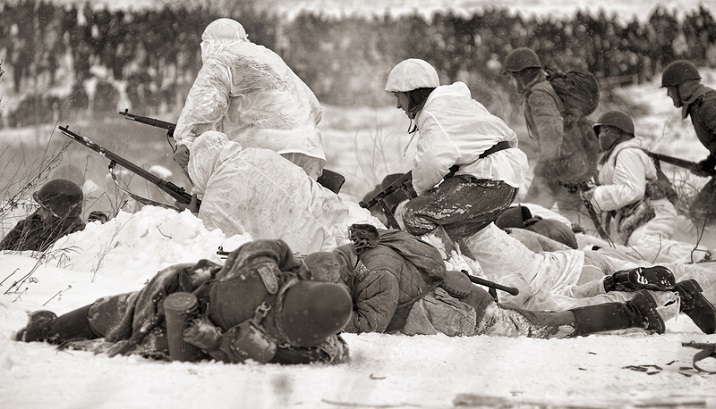
In mid 1950s biathlon was introduced into the Soviet and Swedish winter sport circuits and was enjoyed by the mass. The first Biathlon World Championship was held in 1958 in Austria. Finally it was in 1960 Biathlon was included in the Olympics. Women were first allowed in Olympic Biathlon at Albertville in 1992.
Participating Countries
Biathlon is highly dominated by northern Europeans, especially by athletes from Russia, Finland, Germany and Norway. The only non-European to hold an Olympic Biathlon title is Canadian Myriam Bedard.
Biathlon at the 22nd Olympic winter games was held in Russia. A mixed relay event was staged in 2011 for the first time. Norway holds six medals for Biathlon.
Biathlon - Equipment
Biathlon is a sport in which skiing and shooting is done in order to win the race. As the game is played on ice so accordingly equipment are needed by the players for playing and providing safety.
Racing Suit
Biathletes need racing suits which should be skin tight for easy movement of the player and also to cut down wind. The suit also has a base layer for insulation.
Gloves
Biathletes need gloves in order to cover their wrist and saving them from getting cold. The gloves shall be made up of lightweight material.
Hats
Biathletes need hat made up of lightweight materials in order to cover their head.
Goggles
Biathletes need goggles in order to save the eyes from glaring sunlight and reflecting snow.
Ski
The ski used by the participants must be stiff and short as it will help them for freestyle skiing. Special glide wax is also applied on the skis.
Rifles
As biathlon is racing and shooting game so besides skis the participants also have to carry a rifle in a harness. The bullets must be of 0.22 caliber which are stored in the magazine. In case of relay three more rounds are stored.
Targets
Metallic discs are put in a small box and are used as targets. If the shooting is successful then a different colored disc is visible to show that shooting is successful. Nowadays computer are also being used to check if the shooting is successful or a miss.
Biathlon - Basics
Biathlon is a game where the athlete has to ski as well as shoot at the target in order to win the race. For every missed target he has to face a penalty. Here we will discuss the basics of the game.
Skiing
Here the participants use freestyle or skate method instead of cross country skiing method where the ski has to touch the snow. In freestyle skiing a participant puts the ski alternatively in the snow. The method also depends on whether the skier is going downhill or uphill as the participants do not use the poles in downhill but use it in uphill to push themselves.

Shooting
Before the start of the competition, the participants and their coaches adjust the rifles according to the temperature and weather conditions. During the race, coaches also advice the participant about the shooting style. A coach may also let the participant know how much he/she is behind the other participants.
Biathlon - How to Play?
The biathlete should be completely fit to ski fast on cross country. Controlled heart rate is required for precise target shooting. Each biathlete holds a rifle and shoots the target from a distance of 50m (160ft).
The game has different stages and accordingly the shooting position of a biathlete can be either prone position or standing position. The target diameter is 1.8 inches or 45mm in case of prone position and 115mm or 4.5 inches in standing position.
Winter Olympics biathlon includes five events. They are individual, sprint, pursuit, relay and mass start competitions. The details of each event is given below −
Individual
Individual race is the oldest event of biathlon. The male biathlete runs a distance of 20km while the female runs over 15 km. In this event the skier has to shoot four targets each in five laps. The shooting positions for the target is prone, standing, prone, standing. If the target is missed then a one minute penalty is imposed.
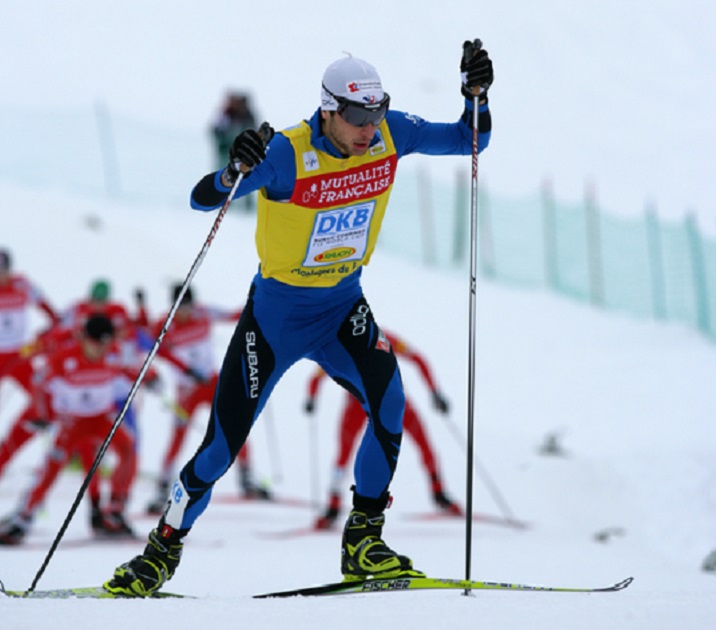
Sprint
Sprint has 10 km distance for males and 7.5km for women. Here the distance is covered three laps. The biathlete shoots once in the standing position while second time in the prone position. Every time a shot is missed a penalty loop of 150m is to be skied before the race can be continued.

Pursuit
Contestants for the pursuit event are chosen from the sprint event. Top 60 finishers of sprint race qualify for this event. The pursuit race is of 12.5 km for males and 10 km for females. Biathlete with the best timings in sprint event starts the race and is followed by other deserving candidates accordingly. The objective of this race is to accompany the leader and patch up ground to be the first to cross the finishing line.
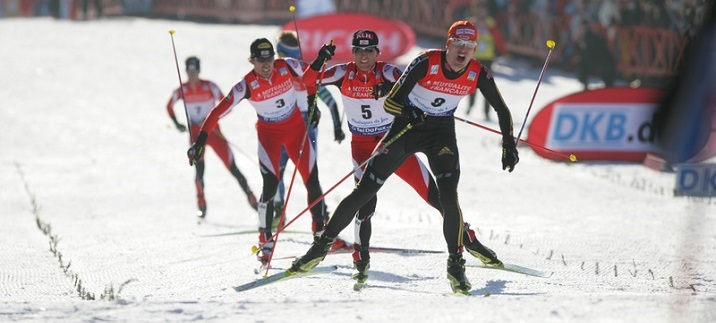
The pursuit race is parted into five laps and four shooting bouts. Here the racers can team up at the target areas of the race. Its better to shoot in the sequence of their arrival at the shooting range. Mostly this means that the racers simply stand and wait for their turns. Every time they miss a target a penalty loop of 150m is imposed before the racer can go along the course.
Relay
In this event all the biathletes start at the same time from the same source. After completing their course, the biathletes have to touch the next biathlete who will be running the next part of the race. For male biathletes relay is a 4 x 7.5 km and for female biathletes relay is a 4 x 6 km.

In short, all the four biathletes have to cover the distance in three laps and two shooting bouts. All qualified biathletes have to perform two shooting rounds. In each shooting round the biathlete faces five targets. In case if a shot is missed they are given three chances to manually load the bullet and try again. For the fourth time a penalty loop of 150m is to be covered.
Mass start
Mass start is the latest event that was included in biathlon events in 2006 Winter Olympics in Turin. In this event top 30 biathletes who managed to maintain the best scores in other four events start the race altogether. For male biathletes mass start is a 15km race and for female biathletes it is 12.6km. There are five laps and four shooting rounds and for each missed target a penalty loop of 150 m is to be covered.
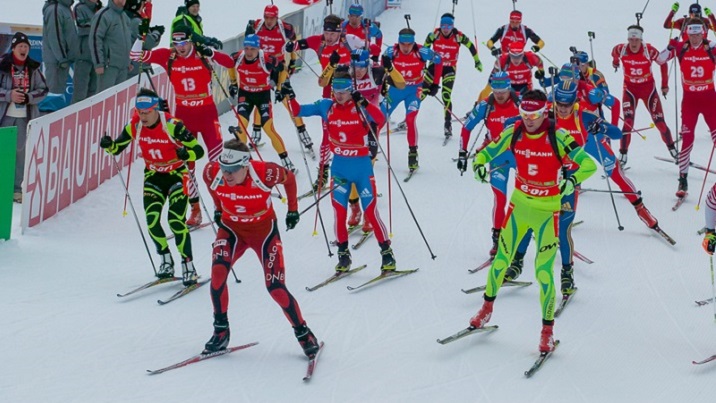
These five mini collections of games make biathlon an interesting and exciting game. This winter sport is pretty much challenging and needs complete dedication, stamina and concentration. After understanding the game a brief description regarding how to play the game is illustrated below.
Understanding the game − The aim of the game is to ski fast. The biathletes ski within a rifle range to shoot five targets in prcised shooting positions. That is either standing position or prone position.
Fitness of Participants − For biathlon the player should be highly fit as apart from fast skiing the players should keep their heart rate calm and as low as possible in order allow for precise target shooting. As mentioned earlier the motto of the game is to hit all five targets. Every time the bullet hits the target, a metal panel encloses making it a successful hit. Every time the target is missed ski penalty loops sums up with the time scored. So more misses, gets more penalty loops to be skied for the skier.
Steps taken by a Biathlete − Then the biathlete leaves the range, skis off on the next loop, returns into the range and the cycle goes on unless the race distance is completed. Say for example, a biathlete has to complete a 10 kilometer course, the race might be 4 by 2.5 kilometers that is 2.5 mi 1.6 mi loops and every time the biathlete enters the same range five targets are to be shot.
The winner − The biathlete who completes the race with minimum time including the penalty loops as compared to other qualified biathletes becomes the winner. A wise step for taking minimum time would be not wasting time skiing additional penalty loops and focus on precise shooting.
Special Requirements for Biathlon
Shooting lessons are recommended before participating in this game. A license for owning a gun along with safely handling a firearm is a must. Its obvious to have a gun license but here the class of gun license should have permit to use a rifle for competition purpose.
Biathlon - Rules
Rules for Biathlon are decided by International Biathlon Union(IBU). Lets understand the rules to be followed while playing Biathlon.
The biathlete skis from different distances from 6km to 20 km and halts at the shooting range to target two or four times. Here both the ski distance and number of shooting sessions depend on the type of competition in question.
The distance from which the target is shot is always 50 m. In every session five rounds are shot at five targets. In relay competition the biathlete has three spare rounds for each session.
The diameters of the target completely depend on the shooting position and are very small. When shooting in the standing position it is 115 mm in diameter, while shooting in the prone position the target is even smaller that is 45 mm. The clock never stops during the entire series of events. So the biathletes do not just have to ski and shoot the target but also make it fast.
Except for the Individual event penalties like adding extra one minute of added time for each target missed or a 150m penalty loop immediately after each session of shooting are charged for every target missed. While in Individual event penalty is done after the session is over.
As an attribute to the sports, the biathlete begins at the start line, skis one course loop whose length depends on the event, comes within the shooting range and shoots at the target. Then he skis another loop and shoots again and finishes with a ski loop to the finish line after the last shooting session.
The Individual and Sprint events begin with one biathlete at a time with a gap of 30 seconds. The pursuit event is based on time intervals on the basis of qualifying competition. In the mass start all biathletes begin at the same time from the same place.
In the relay event, the first members of all teams begin the race at the same time and after covering their part, they tag the next team member in the Hand-over Zone to initiate them on their path.
From the beginning of the race till the end, the biathletes are responsible for their own actions and decisions made, like selecting a shooting lane allocated in the Relay and Mass Start, counting total number of targets they missed to shoot, and then skiing the correct number of penalty loops. Apart from this they are expected to follow the stipulations of the Event and Competition Rules.
A new concept of Relay race that is Mixed Relays are also held, where the female biathletes complete the first and the second part of the relay race, whereas the third and fourth part of the race are completed by male biathletes. However the Mixed Relay follows all other procedures and rules from the relay race.
Biathlon - Championships
The International Biathlon Union (IBU) is the governing body of Biathlon. Given below are some major International Biathlon events in contrast to the Olympics, World Championships and the World cup.
- Biathlon at Winter Olympics
- Biathlon World Cup
- Biathlon Junior World Championships
Biathlon at Winter Olympics
Biathlon was introduced in Winter Olympics of 1960 having the individual event of 20km. Relay of 4 x 7.5 km was introduced in 1968 Winter Olympics and sprint of 10km in 1980 Winter Olympics. Women debuted in this game in 1992 Winter Olympics. Most of the gold has been won by Germany and next to it is Norway.
Biathlon World Cup
The Biathlon world cup for men was started in 1977-78 season and for women in 1982-83 season. Firstly it was called European cup but later on it was introduced as world cup. The world cup is mostly held in between November and March. The event includes relay race 4-6 times. After the end of whole event a Big Crystal Globe trophy is awarded to the winner. The winner is the one who has the highest total points.
Biathlon Junior World Championships
The Biathlon World Junior Championships were started in 1967 for men and in 1984 for women. Previously the venue for these championships were same as the world cup. Later the venues were changed to Czech Republic, Finland, and Austria.
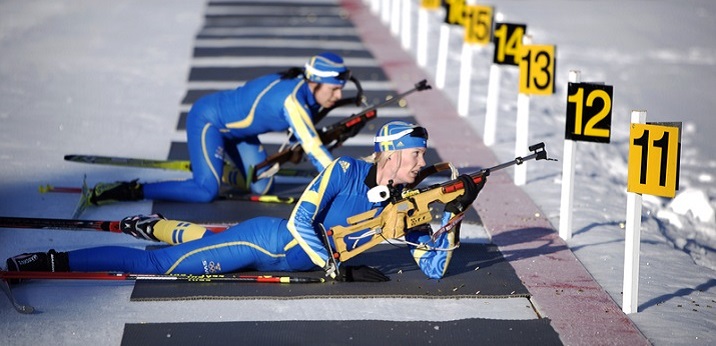
Biathlon - Champions
There are many athletes who take part in various competitions of some or all the events of biathlon. Let us take a look at some of the champions of Biathlon and their careers −
Martin Fourcade
Martin Fourcade is a biathlete from France who has won overall world cup five times and he is the only biathlete to do so. Along with this he also won Olympics two times. Martin started his career in 2002 and in 2006 he started participating at international level.
He won bronze medal in junior championship in 2007. Since 2007 he kept participating and improving his rank. After 2010 winter Olympics he took part in world cup and won a silver medal. He won 2009-2010 Pursuit world cup.
In 2011, world championship he took part in mixed relay and finished 3rd. He also won a silver medal in sprint event of biathlon. After that he took part in pursuit event and won gold. In 2012-2013 session he won silver in world championships in sprint and pursuit and a gold in individual. In 2013-2014 session he won a gold in mass start event in world championship and 2014 Olympics.
Jakov Fak
Jakov Fak is a Slovenian biathlete born in Croatia. In 2009 world championship he won a bronze medal. He also got a bronze medal in 2010 winter Olympics. He won this when he was a member of Croatia team.
After the 2010 Olympics, he joined Slovenian team and won a gold in 20km event and silver in mixed relay. In 2012 world cup he won a silver medal in mixed relay and a gold medal in individual event. In 2015 he won a gold medal in mass start event.
Targei Bo
Targei Bo is a biathlete from Norway got his first world cup victory in 2010. He started his career in 2006 and won a gold in individual event and a silver medal in pursuit event. In 2010 Olympics he claimed a gold in relay event.
In 2011, he won a sprint race in the world cup. He also won gold in relay and mixed relay events. In 2012 world cup he won a gold and in 2013 world cup he won three golds in different events. In 2015 he won four bronze medals and one silver medal in different events while in 2016 he won a gold and a bronze.
Ole Einar Bjorndalen
Ole Einar Bjorndalen is a biathlete from Norway who has got the nick name of king of biathlon as he is the winner of most of the medals in this game. He won world cup title six times.
He won his first medal in 1992 in junior championships and three medals the next year. Till Feb 2014 he won eight gold four silver and one bronze in Olympics and 20 gold medals in world championships. He has won sprint race nine times and pursuit event five times.
Emil Hegle Svendsen
Emil Hegle Svendsen is a biathlete from Norway who has won two gold medals and one silver medal in 2010 Olympics. In world championship also he is very successful as he is the winner of five gold medals in individual event and six gold medals in relay event.
In 2007, he won 20km event and two gold medals in 2008 world championships. In total he has won four golds and one silver in Olympics and twelve gold, 6 silver, and three bronze in world cups.
Marie Dorin Habert
Marie Dorin Habert is a biathlete from France who took part in 2010 winter Olympics. She won a bronze medal in 2009 world championship and a bronze in sprint and silver in relay in 2010 world championship.
In 2015 World Cup, she won sprint event and pursuit event which were her first and second victory respectively. In 2016 World Championship, she won one gold each in individual, mass start, and mixed relay events, one silver each in sprint and relay events and one bronze in pursuit event.
Tora Berger
Tora Berger is a biathlete from Norway who is now retired. She joined the biathlon team in 1999. In 2008, she won a silver medal in mass start. In 2010 Winter Olympics, she won a gold medal in 15km event.
In 2013 World Championship, she won a gold in mixed relay and gold in pursuit. In 2014 Winter Olympics also she won one gold, one silver, and one bronze in mixed relay, pursuit, and relay events respectively.
Ekaterina Iourieva
Ekaterina Iourieva is a Russian biathlete who started her career in 2005 but could not win any medal. In 2007-2008 season, she won her first medal in world championships. She also won a gold medal in individual event and a silver medal in pursuit.
In 2008-2009 session, she won sprint and mass races. Then she took part in individual race and won that too. In this season she was tested for doping and the results were positive which led to her disqualification.
Andrea Henkel
Andrea Henkel is a biathlete from Germany who became the permanent member of the countrys team in 1998. She won her first medal in 1999. In her full career she won a gold in 2002 Olympic in individual event and a gold in relay.
In 2006 Winter Olympics, she won a silver in the relay race. In 2010 Olympics, she won a bronze medal in relay. Total number of medals in world championship include eight gold, six silver, and two bronze medals.
Magdalena Forsberg
Magdalena Forsberg is a biathlete from Sweden. She is the six times world championship winner and she also won bronze medals two times in Olympics. She had started her career as a cross country skiing player.
She took part in 1992 Winter Olympics and attained seventh position. She was in skiing team from 1988 to 1996. Later she joined biathlon team and won six medals in world cup held from 1997 to 2002.